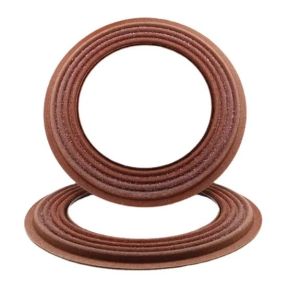Damper

Damper, also known as the spider, is a critical component in the design and functionality of loudspeakers. It plays a key role in controlling the movement of the speaker cone and maintaining its alignment. Here's an in-depth look at the damper in speakers:
Purpose and Function[edit | edit source]
- Stabilization: The primary function of the damper is to stabilize the voice coil and speaker cone, ensuring that they move precisely in a linear direction without tilting or wobbling.
- Restoring Force: It provides a restoring force that centers the voice coil in its magnetic gap. This is crucial for maintaining the accurate positioning of the voice coil, allowing it to move back to its neutral position after displacement.
- Flexibility and Control: The damper must be flexible enough to allow the necessary movement of the cone while also providing enough control to prevent excessive or uncontrolled motion.
Design and Material[edit | edit source]
- Shape and Structure: Dampers are typically disc-shaped with a corrugated or pleated design. This design allows for the necessary flexibility and movement while providing the needed stability.
- Materials Used: Common materials for dampers include fabrics impregnated with resins, polymers, or other synthetic materials. These materials are chosen for their durability, flexibility, and resistance to environmental factors such as humidity and temperature changes.
Types of Dampers[edit | edit source]
- Soft Dampers: These provide greater flexibility and are used in speakers where more extensive cone movement is required, such as in subwoofers.
- Stiff Dampers: These offer more control and are used in speakers where precise movement is crucial, such as in high-frequency drivers or tweeters.
Impact on Performance[edit | edit source]
- Sound Quality: The damper’s ability to control the cone’s movement directly affects the speaker’s sound quality. A well-designed damper ensures minimal distortion and accurate sound reproduction.
- Durability: High-quality dampers contribute to the overall durability of the speaker, preventing wear and tear that can lead to performance degradation over time.
- Efficiency: Efficient damping improves the speaker's overall efficiency by ensuring that the energy from the voice coil is effectively converted into sound rather than being lost through uncontrolled movements.
Maintenance and Care[edit | edit source]
- Regular Inspection: Check the damper for signs of wear, such as cracks, tears, or deformation, which can affect its performance.
- Environmental Factors: Keep the speaker in a controlled environment to prevent damage from humidity, temperature changes, and dust, which can degrade the damper material.
Innovations and Trends[edit | edit source]
- Advanced Materials: Research into new materials and composite structures is leading to the development of dampers with improved performance characteristics, such as better durability and enhanced flexibility.
- Precision Engineering: Advances in manufacturing techniques allow for more precise control over the damper’s properties, leading to improved speaker performance and reliability.
- Customization: Some high-end speaker manufacturers offer customizable dampers tailored to specific performance requirements, allowing for fine-tuning of the speaker’s sound characteristics.
Conclusion[edit | edit source]
The damper is a crucial yet often overlooked component of loudspeakers. Its role in stabilizing the cone and voice coil, providing restoring force, and controlling movement is essential for accurate and high-quality sound reproduction. Understanding the importance of the damper and ensuring its proper maintenance can significantly enhance the performance and longevity of your speakers.
By focusing on material advancements and precision engineering, the future of speaker dampers promises even better sound quality and reliability.